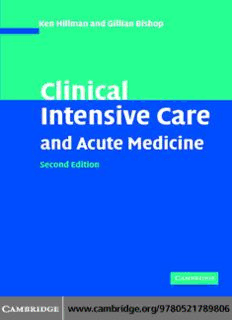
Clinical Intensive Care and Acute Medicine PDF
Preview Clinical Intensive Care and Acute Medicine
Clinical Intensive Care and Acute Medicine Thisneweditionprovidesanaccessibleaccountoftheessentialsofintensive caremedicine.Thecoreofthebookfocusesonareascommontoall criticallyillpatientsincludingfluidtherapy,sedation,shock,infectionand othercentraltopics.Thiskeyunderstandingofbasicpathophysiological principlesprovidesanexcellentlaunchpadforthesectiononindividual dieseaseentitiesencompassinghaematology,gastroenterology,nephrology, endocrinology,therespiratorysystem,cardiovascularpathology,poisoning andneurology.Economicandethicalissuesarealsocovered,andthetextis supportedbynumerousproblem-orientedguidelinestohelpthecare providertacklereal-lifepracticalproblemsasencounteredintheICU.Inthe samespirit,whereverpossible,theauthorsprovidepreciseandmeaningful advice,ratherthanblandgeneralisations.Thisneweditionreflectsthe excitement,challengesanduniquenessofintensivecaremedicine,forthe benefitofallresidents,trainees,nursingstaffandparamedicsattachedtothe ICU. ‘Whilethebookisspecificallydirectedatjuniormedicalofficers,itwillalsobe usefulasanaidtothepart-timeintensivistandpostgraduatemedicalandnursing education.Evenforthoseintensivecareunitsthatalreadyhavewelldefined protocols,thisbookwillfulfilaninvaluableeducationalrole.Thisbookisan essentialadditiontoallintensivecarelibraries.’AnaesthesiaandIntensiveCare ‘Forthoseofuswhorunintensivecareunits(ICU),facedwithtraineesofvarying experiencewhosefirstquestionontheunitis“WhatbookshouldIbuy?”.Icannow tellthem–thisone.IrecommendthistextstronglyfortraineesinICU.Itwillalso proveusefulforthosepreparingtotakeafellowshipexamination.Itisextremely goodvalue.’BritishJournalofSurgery ‘Theclinicalcontentofthebookissoundandcomprehensiveandtheauthorsare clearlymastersoftheirtopic.Thevolumeunderreviewiscertainlyaworthyaddition toaburgeoningliterature.’JournaloftheRoyalCollegeofPhysiciansofLondon ‘Iappreciateditspragmaticapproachtocomplexproblemsolving.It’ssize, comprehensivecoverageandcostshouldmakeitanattractivecompetitorforother wellestablishedtextsinthesamearea.’Anaesthetist ‘Thebookconveystheinformationwithacombinationofcleardescriptive paragraphsandbulletedpointsallowingeasyreference.Attheendofmanychapters thereare‘trouble-shooting’sectionsthathighlightspecificcommonproblemssuch asoliguria–problem-orientedliststhatcanbequicklyreadbythejuniordoctorin timeofneed.Ilikethisbookforitsclarityandconclusion.Verydefinitelyauseful on-call-roomcompanion.’JournaloftheRoyalSociety Clinical Intensive Care and Acute Medicine Second Edition Ken Hillman and Gillian Bishop TheLiverpoolHealthService Sydney cambridge university press Cambridge, New York, Melbourne, Madrid, Cape Town, Singapore, São Paulo Cambridge University Press The Edinburgh Building, Cambridge cb2 2ru, UK Published in the United States of America by Cambridge University Press, New York www.cambridge.org Information on this title: www.cambridge.org/9780521789806 © Ken Hillman and Gillian Bishop 1996, 2004 This publication is in copyright. Subject to statutory exception and to the provision of relevant collective licensing agreements, no reproduction of any part may take place without the written permission of Cambridge University Press. First published in print format 2004 isbn-13 978-0-511-18455-0 eBook (NetLibrary) isbn-10 0-511-18455-7 eBook (NetLibrary) isbn-13 978-0-521-78980-6 paperback isbn-10 0-521-78980-x paperback Cambridge University Press has no responsibility for the persistence or accuracy of urls for external or third-party internet websites referred to in this publication, and does not guarantee that any content on such websites is, or will remain, accurate or appropriate. Contents Listoftroubleshootingtips page xi Prefacetothefirstedition xiii Prefacetothesecondedition xv Acknowledgements xvi 1 Asystematicapproachtocaringfortheseriouslyill 1 2 Organisationofanintensivecareunit 7 Thespecialtyofintensivecaremedicine 7 Intensivecarepersonnel 8 Wardroundsandcontinuity 9 Relativesandfriends 10 Qualityassurance 11 3 Routinecareoftheseriouslyill 15 Howtoapproachapatientinintensivecare 15 Physicalassessment 16 Routinemonitoring,observationsandinvestigations 24 Intravascularlines 26 Intubationandtrachealcare 27 Fluids 31 Gastrointestinaltracthaemorrhage 32 Nutrition 33 Ageandtheseriouslyill 34 Patientreactiontointensivecare 35 4 Fluidtherapyandelectrolytes 41 Assessmentofbodyfluidspaces 41 Fluidreplacement 46 Perioperativefluids 49 Colloidorcrystalloid 53 v vi Contents Specialproblems 53 Electrolytes 56 5 Nutritionandmetabolism 67 Metabolicresponsestoillnessandsubstrateutilisation 67 Enteralnutrition 68 Intravenousnutrition 72 6 Acid–basebalance 79 BodypHregulation 79 Acidosis 82 Alkalosis 85 Mixeddisorders 86 7 Sedation,analgesiaandmusclerelaxants 89 Assessingtheneedforsedation 89 Featuresofthemainsedativegroups 91 Choiceofdrug 92 Modeofdelivery 94 Complicationsofsedation 95 Musclerelaxants 96 Otherformsofpainrelief 98 8 Shockandanaphylaxis 103 Generalfeaturesofshock 103 Classificationofshock 104 Adverseeffectsofshock 106 Anaphylaxis 108 9 Multiorganfailure 111 Manifestationsofmultiorganfailure 111 Quantificationoforgandysfunction 113 Pathophysiology 113 Management 114 Outcome 115 10 Cardiopulmonaryresuscitation 117 Initialmanagementinthehospitalsetting 117 11 Bodytemperaturedisorders 127 Hypothermia 128 Hyperthermia 132 Heatstroke 133 Malignanthyperthermia 135 Neurolepticmalignantsyndrome 137 Contents vii 12 Transportoftheseriouslyill 141 Retrieval 142 Retrievalsystem 142 Intrahospitaltransport 145 13 Infection 149 Sourceofinfection 149 Septicaemia 153 Approachtotheunidentifiedinfection 166 Antimicrobials 171 Intra-abdominalsepsis 185 Wounds 188 Legionnaires’disease 191 Toxicshocksyndrome 191 HumanImmunodeficiencyVirusinfection 192 Viralinfections 195 Fungalinfections 198 14 Trauma 207 Multitrauma 207 Thetraumasystemandscoring 221 Bluntabdominaltrauma 223 Thoracicinjuries 227 Cardiacinjuries 237 Greatvesselinjury 239 Spinalinjuries 240 Genitourinarytrauma 241 Penetratingtrauma 243 Burns 244 Electricalinjuries 248 Crushinjuriesandacutecompartmentsyndrome 251 Neardrowning 254 Traumainobstetricpatients 257 15 Poisoning 265 Initialassessment 265 Specialproblems 268 Activemeasures 270 Somespecificpoisons 274 16 Acuterespiratoryfailure 287 Introduction 287 Failureofoxygenation 288 Failureofventilation 291 viii Contents Principlesoftreatment 292 Oxygendelivery 295 Oxygenconsumption 304 Miscellaneousconsiderations 304 Matchingoxygendeliveryandconsumption 305 17 Interpretationoftheportablechestfilm 311 Aroutineforinterpretation 312 Tubesandcatheters 314 Differentiatingintrapulmonarypathology 315 18 Specificrespiratoryproblems 325 Cardiogenicpulmonaryoedema 325 Acuterespiratorydistresssyndrome(ARDS)andacutelunginjury(ALI) 328 Pneumonia 332 Primarypneumonia(communityacquired) 333 Nosocomialpneumonia 339 Aspiration 346 Hypoventilation 349 Upperairwaysobstructioninadults 349 Postoperativechestcomplications 351 Atelectasisandcollapse 353 Unilaterallungpathology 357 Acutesevereasthma 358 Chronicairflowlimitation(CAL) 365 Pulmonaryembolism 369 Obstructivesleepapnoea 373 19 Ventilatorytechniques 377 Intermittentpositive-pressureventilation 377 Complicationsofpositiveintrathoracicpressure 378 Positiveend-expiratorypressure 382 Choosingtherightventilatorymode 382 Adjustingtheventilator 390 Weaning 390 Theworkofbreathing 392 Humidification 394 20 Cardiorespiratorymonitoring 399 Non-invasivemonitoring 400 Invasivemonitoring 405 Monitoringofgasexchange 411 21 Acutecardiovascularfailure 415 Pathophysiology 415 Treatmentofacutecardiovascularfailure 419 Contents ix 22 Specificcardiovascularproblems 431 Arrhythmias 431 Rightventricularfailure 441 Severehypertension 443 Acutecoronarysyndromes 447 Cardiogenicshock 451 Aorticdissection 455 Cardiactamponade 457 23 Acuteintracranialdisasters 461 Pathophysiology 462 Principlesofmanagementofraisedintracranialpressure 469 24 Specificintracranialproblems 475 Coma 475 Globalischaemia 480 Cerebralinfarction 482 Spontaneousintracerebralhaemorrhage 484 Severeheadinjury 488 Viralencephalitis 496 Bacterialmeningoencephalitis 498 Braindeath 504 25 Criticalcareneurology 509 Myastheniagravis 509 Guillain–Barre´syndrome 512 Criticalillnesspolyneuropathyandmyopathy 516 Tetanus 519 26 Acuterenalfailure 523 Acuterenalfailureinintensivecare 523 Preventionofacuterenalfailure 527 Managementofrenalfailure 531 Modeofdialysis 533 27 Criticalcaregastroenterology 543 Fulminanthepaticfailure 543 Acute-on-chronicliverfailure 549 Liverdysfunctionincriticalillness 549 Ascites 551 Pancreatitis 552 Acutestressulceration 558 Uppergastrointestinaltractbleeding 562 Lowergastrointestinaltractbleeding 566 Acuteabdominaldisordersinthecriticallyill 567
Description: